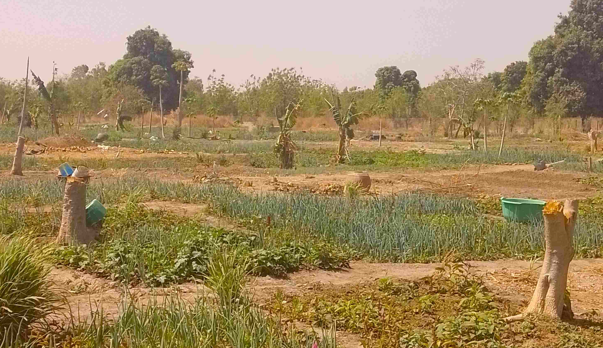Mali – During a visit to the field, you see the theoretical proposals become reality. You learn and understand with your own eyes, you hear the positive and sometimes negative observations of the people for whom the activities are intended, you feel the heat and the sand… And you realise that – in this case – Mali is facing major challenges, but that change and adaptation are possible. We visited a vegetable garden in Koursalé where activity is buzzing, thanks to better access to water for crops.
In Koursalé, we greeted the village chief surrounded by his elders. Although he himself is old and blind and can no longer move around his village, he tells us that he receives nothing but positive reports from his fellow villagers. We had a long chat with several representatives of the community before heading off to the vegetable garden. The president of the women’s association gave us a very good impression of the leadership and management of the 200 women farmers.
A tree full of food
The vegetable garden had not been used for several years due to inadequate infrastructure, some of which had broken down, and the theft of certain components. Here, two new solar-powered pumps have been installed, the fence has been renovated, and distribution basins have been built, as well as a basin for fish farming. Trees were planted in the garden when it was not yet possible to grow vegetables, mainly papaya and moringa. The moringa is a tree whose leaves and fruit are highly nutritious and can be used for a variety of purposes. This tree is also highly resistant to drought. The diseased papaya trees have been cut down. The moringa trees, which prevent sunlight from penetrating the vegetable beds, have been pruned. New trees are being planted along the fence to act as a living hedge.
1.5 hectares
Nearly 200 women now work on a total of 1.5 hectares. Since the garden was restored, a further 0.5 hectares have been brought into use, for which no water was previously available. However, watering the vegetables could be more efficient, and we are working on this. We need to study the techniques and times that best suit the women’s abilities and their daily schedule. We are also looking at techniques to improve soil moisture retention and reduce crop dehydration.
Today, water is readily available in the garden and tubs are filled from the distribution basins. In the morning and evening, the vegetables are watered using a small container or a watering can. At the time of our visit in February, onions and amaranth were growing mainly in mixed crops. The advantage of onions is that they yield well and can be stored for a long time; not just the bulbs, but also the foliage which is chopped up and dried.
Fulfilment
At the start of the rainy season, in June, new moringas ,other trees and shrubs will be planted along the fence, reinforcing an impenetrable hedge. After being processed, the fry (young fish) will be released into the pond for fish farming.
We also spotted little egrets in the fields. These short-necked white herons were previously absent, but they are useful because they eat caterpillars and other parasites. The water and shade available encourage the birds to dwell.
There are latrines in the garden, which can be improved so that the residue can be used as manure. Compost and animal manure are already used.
But for the 200 women and their families, this vegetable garden is already a source of fulfilment, both literally and figuratively. The dynamism of these women and the sheer number of them will probably require that the vegetable garden is expandeded in the future.
Original text: Harald van der Hoek

